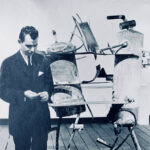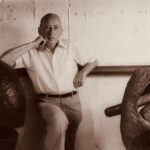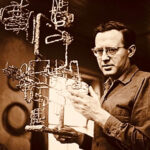John Chamberlain
John Chamberlain (1927-2011) was an American sculptor renowned for his dynamic and colorful works made from crushed automobile parts and other discarded metal materials. Over a career spanning six decades, Chamberlain transformed industrial detritus into vibrant, abstract sculptures that bridge the gap between Abstract Expressionism and Pop Art. His ability to find beauty in wreckage and to create harmony from chaos has left a lasting impact on contemporary sculpture.

Early Life and Education
John Angus Chamberlain was born on April 16, 1927, in Rochester, Indiana. He was raised in Chicago by his grandmother after his parents divorced when he was young. Chamberlain’s early exposure to the mechanical world came from working in a factory and serving in the U.S. Navy during World War II. This experience would later influence his choice of materials and his approach to sculpture.
After his military service, Chamberlain used the G.I. Bill to study art at the Art Institute of Chicago from 1951 to 1952. He then attended Black Mountain College in North Carolina, an experimental institution known for its progressive educational philosophy and its association with avant-garde artists and thinkers. At Black Mountain College, Chamberlain was influenced by the teachings of Charles Olson, Robert Motherwell, and Franz Kline, all of whom encouraged experimentation and innovation in art.
Discovery of Metal Sculpture
In the mid-1950s, Chamberlain moved to New York City, where he became involved with the burgeoning Abstract Expressionist movement. His early work was influenced by the gestural paintings of artists like Jackson Pollock and Willem de Kooning, but Chamberlain soon began to explore the possibilities of sculpture. His breakthrough came when he started using scrap metal from junked cars as his primary material.
Chamberlain’s discovery of automobile parts as a medium was serendipitous. In 1957, he created his first sculpture from a car bumper, recognizing the potential of the material to convey movement, energy, and emotion. This marked the beginning of his signature style, characterized by the use of brightly colored, crumpled metal pieces that he welded and bolted together into dynamic compositions.
His early metal sculptures, such as “Shortstop” (1957) and “Dolores James” (1959), showcased his ability to transform industrial waste into vibrant, expressive forms. These works retained the original colors and textures of the car parts, creating a sense of immediacy and authenticity. Chamberlain’s sculptures from this period are notable for their spontaneity and their ability to capture the gestural quality of Abstract Expressionist painting in three dimensions.
Important Artwork: “The Privet” (1969)
One of John Chamberlain’s most significant and acclaimed works is “The Privet” (1969), a sculpture that exemplifies his mature style and his mastery of working with metal.
“The Privet” (1969)
“The Privet” is a large-scale sculpture made from crushed automobile parts, including fenders, hoods, and other metal fragments. The work stands approximately eight feet tall and is characterized by its vibrant colors, intricate forms, and dynamic composition. Chamberlain’s use of bright, factory-applied car paint adds a layer of visual excitement and emphasizes the industrial origins of the materials.
The composition of “The Privet” is both chaotic and harmonious, with twisted and contorted metal pieces intertwining in a complex arrangement. The sculpture’s bold shapes and energetic lines convey a sense of movement and tension, as if the materials are caught in a moment of explosive force. Despite the apparent disorder, Chamberlain’s careful placement of each element creates a balanced and cohesive whole.
At the heart of “The Privet” is Chamberlain’s ability to transform the mundane into the extraordinary. By recontextualizing discarded car parts, he challenges viewers to see beauty and meaning in everyday objects. The sculpture’s rough textures and jagged edges invite tactile engagement, while its vibrant colors and dynamic forms evoke a sense of playfulness and joy.
“The Privet” is significant not only for its artistic merits but also for its broader cultural implications. Created during a time of rapid industrialization and consumerism, the sculpture reflects Chamberlain’s response to the changing landscape of America. It embodies a critique of mass production and waste, while simultaneously celebrating the potential for creativity and renewal in the most unlikely materials.
Later Career and Evolution
Throughout the 1970s and 1980s, Chamberlain continued to refine his technique and expand his artistic repertoire. He experimented with new materials and processes, including the use of urethane foam and galvanized steel. His works from this period are characterized by their increased scale and complexity, as well as their exploration of new textures and forms.
In the 1970s, Chamberlain began creating large-scale installations and environmental works, such as “Gondola Juan Dolio” (1973) and “Foam Sculptures” (1970-1971), which pushed the boundaries of traditional sculpture. These works often incorporated a variety of materials, including metal, foam, and plastic, and were notable for their immersive, multi-sensory experiences.
Chamberlain’s contributions to contemporary art were increasingly recognized during his lifetime. He received numerous awards and honors, including a Guggenheim Fellowship in 1966 and a National Endowment for the Arts grant in 1975. His works were exhibited in major museums and galleries around the world, and he participated in important group shows such as Documenta and the Venice Biennale.
Personal Life and Philosophy
John Chamberlain’s personal life was marked by his dedication to his art and his passion for experimentation. He maintained a studio in New York City for much of his career but also spent significant time working in other locations, including Connecticut and Florida. His love for automobiles extended beyond his sculptures; he was an avid car enthusiast and collector, which further influenced his artistic practice.
Chamberlain’s artistic philosophy was rooted in a belief in the transformative power of art. He viewed his sculptures as a way to challenge conventional perceptions and to reveal new possibilities within everyday materials. This approach is evident in the vitality and dynamism of his works, which continue to captivate and inspire viewers.
Despite facing periods of financial difficulty and critical indifference, Chamberlain remained committed to his artistic vision. His perseverance and dedication to his craft are reflected in the body of work he created, which stands as a testament to his talent and his belief in the importance of art.
Legacy and Influence
John Chamberlain’s legacy as a sculptor lies in his ability to transform industrial detritus into vibrant and expressive works of art. His innovative use of scrap metal and found objects helped to redefine the possibilities of sculpture, challenging traditional boundaries and opening up new avenues for artistic expression.
Chamberlain’s influence can be seen in the works of subsequent generations of artists who have been inspired by his inventive approach and his emphasis on materiality. His sculptures, with their combination of abstraction and representation, continue to resonate with viewers and artists alike, reminding us of the potential for creativity and transformation in the everyday world.
Later Works and Continued Innovation
In the later years of his career, Chamberlain continued to experiment with new materials and techniques, creating works that expanded the boundaries of his practice. He revisited earlier themes and forms, often incorporating elements from his previous works into new compositions. This period saw the creation of large-scale installations and public sculptures, such as “Sculpture for a Large Wall” (1975) and “American Tableau” (1984), which further solidified his reputation as a leading figure in contemporary art.
Chamberlain’s later works also reflected his ongoing engagement with color and form. He often used brightly colored, industrially coated metals, which added a sense of vibrancy and immediacy to his sculptures. His ability to balance spontaneity with control, and to create order from chaos, remained a hallmark of his work throughout his career.
Death and Posthumous Recognition
John Chamberlain passed away on December 21, 2011, in New York City, leaving behind a rich legacy of artistic innovation and creativity. His contributions to contemporary sculpture have been widely recognized, and his works are included in the collections of major museums and galleries around the world, including the Museum of Modern Art in New York, the Guggenheim Museum, and the Tate Modern in London.
Since his death, Chamberlain’s work has continued to be celebrated through numerous exhibitions and retrospectives. His influence on contemporary art remains significant, and his sculptures continue to inspire new generations of artists and viewers.
Conclusion
John Chamberlain’s artistic journey is a testament to his creativity, resilience, and profound understanding of form and material. Through his innovative approach to sculpture, he created a body of work that continues to inspire and challenge viewers. “The Privet,” one of his most important works, exemplifies his ability to convey complex ideas and emotions through abstract means.
In celebrating John Chamberlain’s life and work, we recognize his significant contributions to the development of modern sculpture and his enduring legacy as an artist who saw potential and beauty in the overlooked and discarded. His sculptures remain powerful and evocative, reminding us of the transformative potential of art and the importance of seeing the world through new eyes. Chamberlain’s exploration of form and material continues to resonate, inviting us to contemplate the hidden possibilities that lie within the everyday objects around us.



